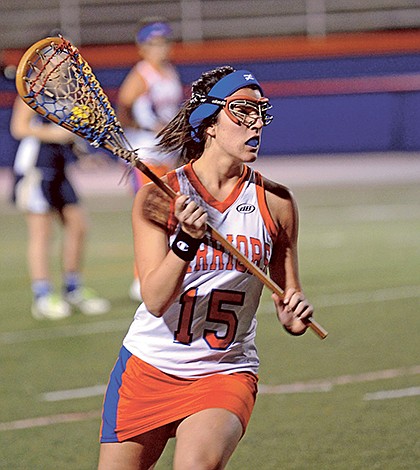- April 4, 2025
-
-
Loading

When the news broke last summer that the FHSAA was going to mandate protective headgear for girls lacrosse, most players and coaches objected and feared the worse.
Pictures circulated of hard helmets, like the ones used in the boys game, and soft helmets, that — in addition to being rather unflattering, aesthetically — critics also suggested could make the game more unsafe by subconsciously encouraging girls to be more aggressive with their sticks.
Despite those strenuous objections from players and coaches, as well as the game’s national governing body, U.S. Lacrosse, the FHSAA held firm on its mandate, and the 2015 season has begun with the mandate in place — though, depending on which teams you are watching, it could be hard to tell from the stands.
Of the seven models of protective headgear approved by the FHSAA, released in a statement on Jan. 15, the one that seems to be the most popular is a 10-millimeter headband. Although the padding is noticeable up close, from the stands, the headbands are hard to differentiate from headbands that many players would wear in previous seasons.
The inclusion of the headband with the other more noticeable options has helped to quell many, but not all, of the concerns many held.
“Most teams went with (the headbands) to try and get as minimal as they possibly could,” West Orange coach Mary Hopkins said. “It could have been much worse had they not approved some of these smaller ones.”
Although nothing of the sort has been said officially on the record, it is fair to see the inclusion of the more minimal headbands as an unofficial compromise of sorts, after the initial mandate got national attention.
“I am really thankful for the compromise,” Olympia senior attacker Ashley Aken said. “The headbands, from afar, look just like normal headbands, which most of us would wear, anyway.”
The aesthetic change may be modest, dependent upon which model a program chose, but the headbands are causing some unexpected problems, as players like Aken noted they do not pair well with the protective goggles the girls already wear and have been a source of headaches during and after competition.
“These are still causing some problems: They’re sliding off players’ heads, or they’re causing their googles to slide off,” Hopkins said. “That’s the main issue right now — the googles really do protect (the girls), and (the headbands) are making them less effective now.”
Not quite halfway into the season, many still are undecided on just how much the mandate is affecting the game. With area programs such as Olympia and West Orange — ranked No. 5 and No. 23 in the state, respectively, by LaxPower.com — looking to position themselves for the playoffs, many players and coaches are rolling with the headgear mandate for the time being as they focus on on wins and losses.
“Was it something we wanted? No. But is everyone doing it? Yes,” Elyse DeLisle, first-year coach at Olympia, said. “We’ve kind of just embraced it.”
“A lot of the other teams have worse (models),” Hughes said, noting her appreciation that Hopkins choose the minimalist headbands. “It’s not that bad; I thought it was going to be worse.”
Whether the game has become more aggressive is also hard to tell less than halfway through the season, although there is a noticeable change in the way officials are officiating.
“Calls have definitely been tighter because it’s what the refs are looking for,” DeLisle said. “But I think that (stricter officiating) has just been a point of emphasis all-around, helmets or no helmets.”
One concern that has yet to be addressed, thanks to the erratic and chilly weather of late, notes Hopkins, is how much of a hinderance the headgear could become as temperatures rise.
Contact Steven Ryzewski at sryzewki@wotimes.com.